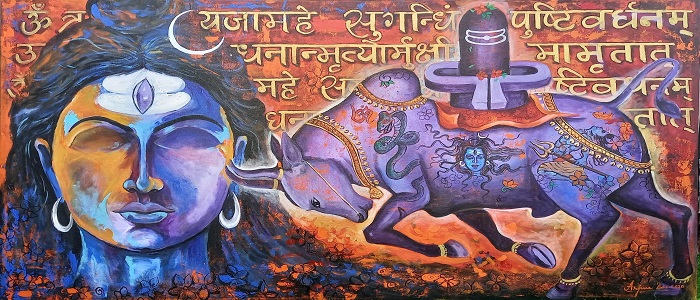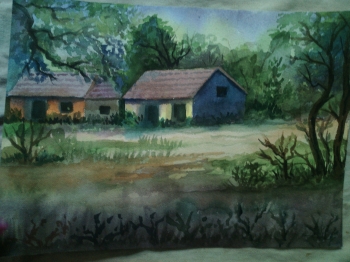
Shiva uses the terms "that which is not" and "Adiyogi" interchangeably because they are similar in many aspects. Investigate the myths and legends surrounding this important character in Indian spiritual traditions.
Shiva's Meaning in Traditional Paintings
When we mention "Shiva," we're referring to two distinct elements. "Shiva" properly translates to "that which is not." Shiva is the state of being nothing. Modern science is showing to us that everything originates from and returns to nothing. The essential characteristic of the cosmos and the foundation of existence is enormous nothingness. The galaxies are merely a sprinkling of events. The rest is nothing but vast space, which is known as Shiva. That is the womb from which everything emerges, and it is the oblivion from which everything is sucked back into. Everything originates with Shiva and returns to Shiva.
Lord Shiva Paintings: Shiva is Darkness
So Shiva is described as a non-being, not as a being. Shiva is not described as light but as darkness. Humanity has gone about eulogizing light only because of the nature of the visual apparatus that they carry. Otherwise, the only thing that is always, is darkness. Light is a limited happening in the sense that any source of light – whether a light bulb or the sun – will eventually lose its ability to give out light. Light is not eternal. It is always a limited possibility because it happens and ends. Darkness is a much bigger possibility than light. Nothing needs to burn, it is always – it is eternal. Darkness is everywhere. It is the only thing that is all-pervading.
But if I say “divine darkness,” people think I am a devil worshiper or something. In fact, in some places in the West, it is being propagated that Shiva is a demon! But if you look at it as a concept, there isn’t a more intelligent concept on the planet about the whole process of creation and how it has happened. I have been talking about this in scientific terms without using the word “Shiva” to scientists around the world, and they are amazed, “Is this so? This was known? When?” We have known this for thousands of years. Almost every peasant in India knows about it unconsciously. He talks about it without even knowing the science behind it.
Meaning of Adiyogi in Lord Shiva Paintings – The First Yogi
On another level, when we say “Shiva,” we are referring to a certain yogi, the Adiyogi or the first yogi, and also the Adi Guru, the first Guru, who is the basis of what we know as the yogic science today. Yoga does not mean standing on your head or holding your breath. Yoga is the science and technology to know the essential nature of how this life is created and how it can be taken to its ultimate possibility.
This first transmission of yogic sciences happened on the banks of Kanti Sarovar, a glacial lake a few miles beyond Kedarnath in the Himalayas, where Adiyogi began a systematic exposition of this inner technology to his first seven disciples, celebrated today as the Sapta Rishis. This predates all religions. Before people devised divisive ways of fracturing humanity to a point where it seems almost impossible to fix, the most powerful tools necessary to raise human consciousness were realized and propagated.
So “Shiva” refers to both “that which is not,” and Adiyogi because, in many ways, they are synonymous. This being, who is a yogi, and that non-being, which is the basis of the existence, are the same because to call someone a yogi means he has experienced the existence as himself. If you have to contain the existence within you even for a moment as an experience, you have to be that nothingness. Only nothingness can hold everything. Something can never hold everything. A vessel cannot hold an ocean. This planet can hold an ocean, but it cannot hold the solar system. The solar system can hold these few planets and the sun, but it cannot hold the rest of the galaxy. If you go progressively like this, ultimately you will see it is only nothingness that can hold everything. The word “yoga” means “union.” A yogi has experienced the union. That means, at least for one moment, he has been absolute nothingness.
When we talk about Shiva as “that which is not,” and Shiva as a yogi, in a way they are synonymous, yet they are two different aspects. Because India is a dialectical culture, we shift from this to that and that to this effortlessly. One moment we talk about Shiva as the ultimate, the next moment we talk about Shiva as the man who gave us this whole process of yoga.
Who Shiva is Not as per the Traditional Paintings

Unfortunately, most people today have been introduced to Shiva only through Indian calendar art. They have made him a chubby-cheeked, blue-coloured man because the calendar artist has only one face. If you ask for Krishna, he will put a flute in his hand. If you ask for Rama, he will put a bow in his hand. If you ask for Shiva, he will put a moon on his head, and that’s it!
Every time I see these calendars, I always decide to never sit in front of a painter. Photographs are all right – they capture you whichever way you are. If you look like a devil, you look like a devil. Why would a yogi like Shiva look chubby-cheeked? If you showed him skinny it would be okay, but a chubby-cheek Shiva – how is that?
Shiva is not regarded as a God in yogic culture. He was a being from the Himalayan region that traversed this land. His contribution to the formation of human consciousness, as the very basis of yogic traditions, is far too amazing to be overlooked. Thousands of years ago, every potential approach of approaching and transforming the human mechanism into an ultimate possibility was investigated. It's incredible how sophisticated it is.
The fact that people were so advanced at the time is immaterial because this was not the result of a certain culture or intellectual process. This was the result of an inward realization.
This had nothing to do with the events taking place around him. It was simply an outpouring of his emotions. He explained what each point in the human system meant and what you could do with it in great detail. Even today, you can't change a thing because he stated everything that needed to be said in such an elegant and brilliant manner. You can only try to figure it out for the rest of your life.
Investigate the various aspects of Shiva depicted in Lord Shiva Paintings Kali.
The significance of the imagery of Kali standing on Shiva's chest is explained by Sadhguru. He tells us a narrative that shows how the feminine part of energy works, as well as Shiva and Kal's complementary responsibilities.
Finally, Sadhguru explains the tantric processes that occurred as a result of this occurrence.
Why is Shiva's Throat Blue portrayed in Traditional Paintings?
Sadhguru explains why Shiva is shown with a blue throat, explaining how the vishuddhi chakra, which is positioned at the pit of the throat and is responsible for filtering out bad influences, is located there.
Shivaya namah namah namah namah namah
Aum Namah Shivaya is a mantra that cleanses the body and aids in meditation. Sadhguru delves into the meaning of chanting this mantra and explains why it should be said as Aum Namah Shivaya rather than Om Namah Shivaya.
Shiva’s Third Eye, Crescent Moon, Trishul, Snake and Nandi the Bull
Sadhguru explains all the key symbols that have traditionally adorned Shiva the Adiyogi. Learn all about the mighty trident or trishul, the crescent moon in his matted locks, the snake that wraps around his blue throat and the third eye on his forehead.
Shiva Purana
The Shiva Purana is an ancient text that includes many aspects of fundamental science it and is a powerful tool to transcend limitations. Presented in the form of stories and parables, this way of expressing scientific truths has been a hallmark of the yogic culture.
Parvati
The wedding between Shiva and Parvati was a grand affair, and the very elite of society were present in all their rich finery and splendour. Then entered the groom, Shiva – dreadlocked, matted hair, ash smeared from head to toe, wearing the fresh skin of an elephant and dripping with blood.
Kailash
Revered by many religions and seen as the most sacred site for pilgrimage in the Yogic culture, it is said in the tradition that Shiva resides in Mount Kailash. Sadhguru explains that this is because he stored everything that he knew on this mountain.
Nataraja – Shiva as the Cosmic Dancer
Shiva is also known as Nataraja – the cosmic dancer or the Lord of the dance. This is a dialectical way of expressing that the cosmos is in dance and the dance is guided by a certain intelligence. Shiva as Nataraja represents the exuberance of creation.
Shiva Linga
In Sadhguru’s words, “linga” means the form. We are calling it the form because when the un-manifest began to manifest itself, or in other words when creation began to happen, the first form that it took was that of an ellipsoid.
Why is Shiva the Destroyer?
Shiva is worshipped across the land of India as the most auspicious aspect of divinity but is also widely known as the destroyer. Sadhguru discusses this paradox and explains the wisdom behind the seemingly negative imagery of seeing the divine as the destroyer rather than the creator. He explains how liberation or mukti become a possibility only in destroying the limited.
3 Stories about Lord Vishnu and Shiva
The Yogic disciplines are noted for their rich symbolism and dialectical presentation of complex notions. The trinity of Brahma, Vishnu, and Shiva, who are shown as the creator, maintainer, and destroyer, is a popular iconography that has penetrated India's spiritual culture. Sadhguru explains why the imagery should not be taken literally and provides three Lord Vishnu and Shiva stories that are full of deeper meaning.
The Birth of Ganesha by Shiva, Ganesha, and Parvati
Sadhguru relates the narrative of Parvati yearning for a child as she grew lonely during Shiva's long wandering years. This desire drove her to seek occult methods to have a child. The storey then takes a dramatic turn when Shiva returns to find this youngster obstructing his way and stomps on him! Find out how Shiva resurrected this beheaded youngster by affixing the head of one of his Ganas to his body.
Shiva and Ganga are two Hindu gods.
In Yogic culture, the powerful Himalayan river Ganga is revered as the most sacred river, and its water is thought to have magical characteristics. Sadhguru deconstructs the symbolism of Ganga originating in Shiva's matted locks by recounting his personal experience trekking in the Himalayas and how a few handfuls of Ganga water kept him going for more than 48 hours without feeling tired.
Mahadeva is Shiva's title.
One entity is held above all as the one who is above all gods - Mahadeva – in a land that is home to 330 million gods and goddesses. This is Shiva, the Adiyogi, the Yoga's originator. Sadhguru explains why Adiyogi was given the name Shiva, as well as the everlasting character of his offering. Adiyogi didn't offer any advice or a quick fix for the difficulties that surrounded him. Instead, he gave universally applicable self-transformation techniques.
Shiva's Throat Is Blue
Shiva is also known as "Neelakantha," or "the One with the Blue Throat," in Yogic mythology. Vishakantha is another name for this Shiva form, which means "one with poison in his throat." Sadhguru tells the narrative of how Shiva came to be known as Shiva. He goes on to explain the significance of Shiva's blue throat and how dealing with prejudice's poison is crucial to one's spiritual development.
Mahashivratri
Mahashivratri, also known as "The Great Night of Shiva," is the most important spiritual celebration in India. Is it, however, merely a festival or does it have a scientific basis? Sadhguru discusses why this night is so crucial and how to prepare for it.





















